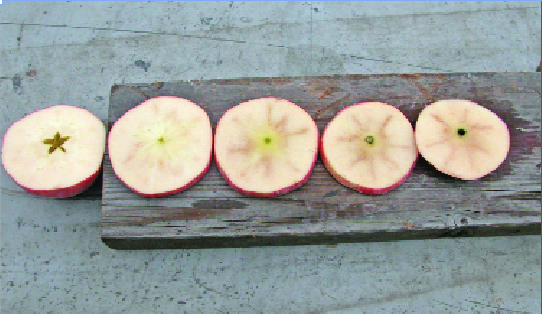The Washington apple industry has spent millions of dollars figuring out how to store Red and Golden Delicious, and now all of a sudden the game has changed. The industry has a new range of varieties that don’t behave the same way as the standard ones, and confounding the issue even further is the recent introduction of MCP (1-methylcyclopropene), a product that enhances the storability of apples but might have other physiological effects on the apples also.
“It’s a grand new experiment,” is how Dr. Gene Kupferman, postharvest specialist with Washington State University, described it during an Apple Fruit Quality seminar organized by WSU Extension in Yakima this summer. “The traditional regimes of rapid CA and low oxygen levels, and MCP treatment on top of that, may not be the way to go.”

Internal browning in Gala is apparent only when the northern hemisphere of the apples is cut.
Photo courtesy of Dr. Dana Faubion, WSU
Firmness
The main reason for putting fruit into controlled-atmosphere temperature and establishing a low-oxygen, low-temperature environment as quickly as possible was to maintain firmness, noted Dr. Jim Mattheis, plant physiologist, with the U.S. Department of Agriculture in Wenatchee, Washington. “The faster you got it into CA, the better the firmness retention.”
But with newer varieties, such as Fuji and Braeburn, this is less of an issue, because firmness doesn’t drop off as quickly as with the older cultivars. And, both Fuji and Braeburn have a tendency to develop internal browning. The faster Fuji is put into CA storage, particularly if it has watercore, the more likely it is to develop internal browning.
Add MCP (SmartFresh) treatment, which slows the dissipation of watercore, and the problem is likely to be worse. “It’s something you need to be careful about,” Mattheis told the attendees. The firmness retention provided by MCP means storage operators don’t need to be in such a hurry to put the fruit into CA conditions, he said.
This allows them to focus on avoiding internal disorders. Mattheis said his early research with MCP focused on what the material was capable of doing. His current research is focusing on how well MCP works on different cultivars at different stages of maturity.
He’s looking at how well fruit treated with MCP can perform in oxygen levels higher than what storage operators, over the years, have found to be optimum and how use of MCP can influence development of various disorders. Use of MCP on Braeburn remains problematic because researchers don’t yet have a regime to recommend that will allow it to be used on that variety with negligible risk of developing browning, particularly core browning, he said. Delaying the MCP treatment was not effective and compromised other quality benefits. So far, there is no way to predict susceptible lots, he said. “MCP may increase browning or not.”
Gala
In the last couple of seasons, internal browning has been showing up in Gala, a variety that was not thought to be susceptible. In fact, Mattheis said he did experiments in the past in which he tried a lot of things to induce it, but without success. “Why, all of a sudden, do we appear to be having these problems when we didn’t have the issue in the past?” he asked.
The browning in Gala is towards the stem end of the fruit, at about the 45th parallel, according to Dr. Dana Faubion, WSU Extension educator in Yakima. It is usually found close to where the stem attaches to the fruit in the stem bowl. It starts out as a light brown discoloration of the flesh, but as it advances, the color turns darker and the flesh in the top half of the apple turns soft, while the bottom of the fruit remains firm.
Faubion saw it for the first time during the 2003 season in MCP-treated fruit in two storage rooms in Yakima. In 2004, a significant amount of fruit was affected throughout the state, though it was mainly in large-sized fruit. Faubion said it doesn’t seem to be directly related to the MCP treatment, and thinks tree nutrition and growing conditions should be considered. But, yet, everything is related to MCP nowadays.
“We harvest our fruit different; we market it different. Everything’s changed, and those changes may impact other aspects of fruit quality,” he said. As Gala becomes an increasing proportion of the Washington State crop, producers must ensure that the fruit is picked at the appropriate time for the storage window, Faubion said.
“There’s one thing that’s clear. We have to get those Galas off the tree at the proper time, and if we don’t, we’ve got to get them sold,” he said. Just because they’re treated with MCP doesn’t mean that they won’t deteriorate, he stressed. The good news, though, is that internal problems can be sorted out with near-infrared technology, he added, and many fruit packers—even smaller ones—are now using on-line nondestructive sorting to prevent affected fruit reaching consumers.
Less ability to respond
Dr. Chris Watkins, horticulturist at Cornell University, New York, said low temperature, low oxygen, DPA (diphenylamine), and MCP all slow down the respiration of the fruit. “We often forget that life requires energy,” he said. “The fruit has no source of energy other than the sugars and acids in the apple.
We’re just about reducing the apple’s ability to respond to its environment. We have to think, as storage operators, that as we’re putting more and more stress on the fruit, we’re cutting down the ability of the fruit to respond to adverse conditions.”
Watkins said internal browning has been a problem in McIntosh apples grown in New York during the past two seasons, and has also affected Empire apples. The industry was alerted to the problem by producers of fresh-sliced apples who noticed it when cutting the fruit.
The internal browning has coincided with the introduction of MCP, and when people look for causes of the problems, they tend to point a finger at new technology that’s being used, Watkins noted. Does MCP worsen internal browning? After some research, his overall conclusion is “no,” though sometimes it might be a factor and other times not.
“It’s very difficult to come out with a categorical answer,” he said. Control of internal browning might involve three storage factors: oxygen level, carbon dioxide level, and temperature. In McIntosh, there is much more flesh browning at low temperatures and low oxygen levels. A temperature of 36°F and 3 percent oxygen level minimized browning in fruit that had been treated with DPA and MCP or had no prestorage treatment.
Benefits of raising the temperature and oxygen levels were not so great for Empire. Watkins said it is possible that even warmer storage temperatures were needed last year to prevent browning. In his tests, the carbon dioxide level (1, 2, or 3 percent) did not affect the amount of browning.
As a rule, there is more chilling injury, such as internal browning, when the temperatures in the orchard in July or August drop below the 30-year average. For Empire, if the weather indicates there is likely to be chilling injury in storage, Watkins recommends raising the oxygen level in storage to 3 percent and the temperature towards 38°F, depending on how long the fruit will be stored and whether MCP has been used.
In a non-chilling year, lower storage temperatures can be safely used. Though MCP appears to increase internal browning in some cases, it might also have a role in solving the problem, as MCP can help maintain the firmness of fruit if it needs to be held at higher temperatures, Watkins said. “MCP allows us the flexibility of backing off on the temperatures without loss of firmness.



Leave A Comment